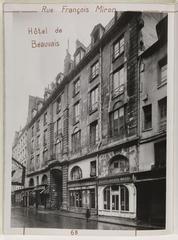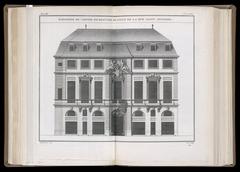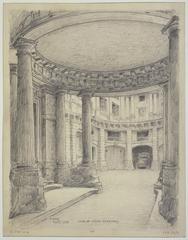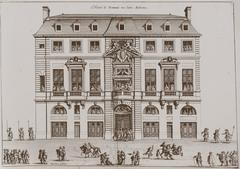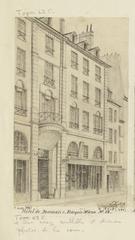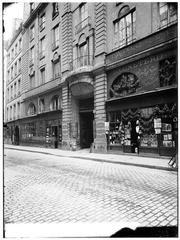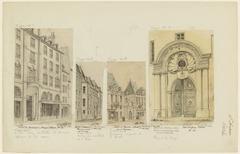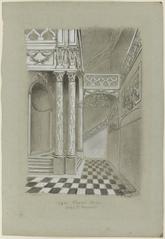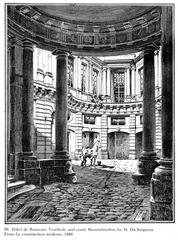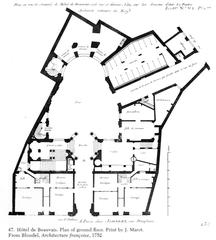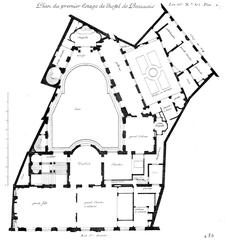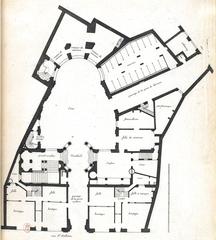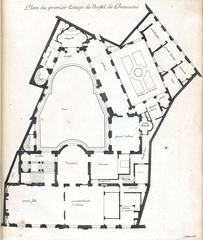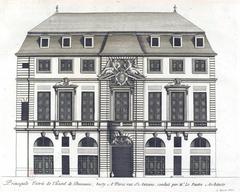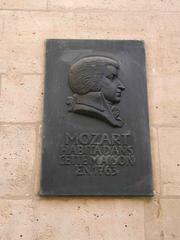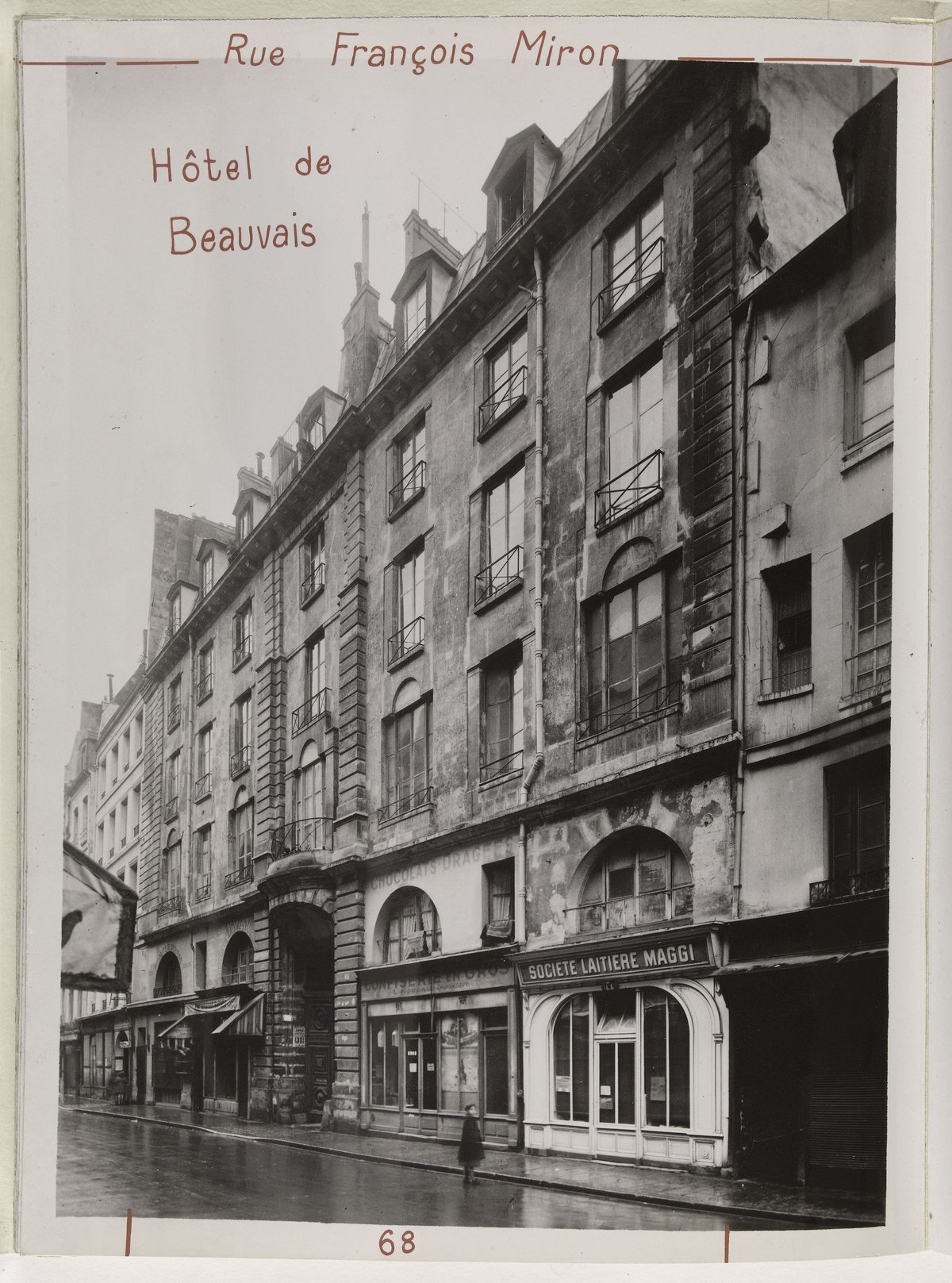
Hôtel de Beauvais Paris: Visiting Hours, Tickets, and Guide to Historical Sites
Date: 14/06/2025
Introduction
Nestled in the storied Marais district, the Hôtel de Beauvais is a striking testament to 17th-century French Baroque architecture and Parisian aristocratic history. Commissioned by Catherine Bellier, lady-in-waiting to Queen Anne of Austria, and designed by the renowned architect Antoine Le Pautre, the mansion stands as an architectural and cultural jewel. Today, it serves as the seat of the Cour administrative d’appel de Paris, with public access granted during special events such as the European Heritage Days. This guide provides a detailed overview of the Hôtel de Beauvais’s history, architectural features, visiting hours, ticketing, accessibility, and nearby attractions—offering everything you need for an enriching visit. For up-to-date information, consult the Administrative Court of Appeal of Paris and the Paris Marais tourism page. (source 1, source 2, source 3)
History and Architectural Significance
Origins and Construction
The Hôtel de Beauvais was built between 1654 and 1657, at the height of the Marais district’s transformation into a fashionable enclave for the Parisian elite. Catherine Bellier acquired the property as a reward for her service to Queen Anne of Austria, and entrusted its construction to Antoine Le Pautre, a leading architect of the Baroque era. The building’s site was unusually irregular, and Le Pautre’s ingenious plan—where no side of the house is parallel—created a harmonious yet dynamic structure that maximized space and light (source 1, source 2).
Architectural Innovations
Le Pautre’s design stands out for its adaptation to the 17-sided medieval plot. The mansion’s main façade, facing rue François-Miron, is marked by strict symmetry achieved through false walls and windows. The unique semi-oval courtyard, suspended garden, and elaborate sculptural details—including ram’s heads as a play on Bellier’s name (“bélier” means ram)—epitomize Baroque creativity and theatricality. The interior once featured lavish painted ceilings, gilded woodwork, and intricate stuccowork, some of which remain preserved (source 2).
Site Context and Urban Setting
Located at 68, rue François-Miron in Paris’s 4th arrondissement, the Hôtel de Beauvais occupies a prominent position along the historic rue Saint-Antoine. The building integrates with the dense, irregular medieval street grid of the Marais, influencing its distinctive form and urban presence (Wikipedia, source 2).
Historical Layers and Foundations
Beneath the Baroque mansion lies a network of 13th-century Gothic cellars, vestiges of the site’s medieval past as a Cistercian abbey house. These atmospheric cellars are occasionally accessible during guided tours, providing visitors with a tangible link to the city’s medieval history (source 2).
Design and Layout
Innovative Planning
Le Pautre placed the mansion directly on the street, a departure from the typical hôtel particulier set-back, to adapt to its restricted site. The carriage entrance opens onto a semi-oval courtyard—an unusual feature in Parisian architecture—while the right wing boasts a suspended garden above the ground floor, and the left wing is balanced by a blind wall for symmetry (source 2).
Façade and Decorative Details
The Baroque façade features vertical rusticated bands and horizontal moldings, with the main entrance marked by a sculpted porte-cochère listed as a historical monument since 1926. Above the entrance, the initials PCHB (Pierre Catherine Henriette Beauvais Bellier) are carved, commemorating the original owners (Wikipedia, source 2).
Interior Highlights
The oval vestibule, supported by Doric columns, creates a dramatic entryway. The grand staircase—an open cage supported by Corinthian consoles and adorned with sculptures by Martin Desjardins—reflects the height of Baroque artistry. The chapel, accessed by an oval staircase, is crowned with a square dome, while the upper apartments and attic rooms preserve elements from the 18th and First Empire periods. The medieval cellars, when open, offer a glimpse into the building’s earlier life (source 2).
Later Modifications and Preservation
Throughout the 18th and 19th centuries, the mansion underwent updates by architects such as Robert de Cotte and Jean-Baptiste Beausire, modernizing interiors while respecting the original design. The 20th century saw less sensitive modifications, but the building was acquired by the City of Paris in 1943 and restored extensively from 2001 to 2003. Since 2004, it has housed the Cour administrative d’appel de Paris (source 2, Wikipedia).
Visiting Hôtel de Beauvais
Visiting Hours
As an active government building, Hôtel de Beauvais is generally closed to the public except for special occasions such as the Journées Européennes du Patrimoine (European Heritage Days) in September. Guided tours may also be offered periodically through specialized agencies (source 1, source 4).
Tickets and Booking
- Tickets: Admission is usually free during European Heritage Days; guided tours may require advance booking and a fee (typically €10–€20).
- Booking: Reserve tickets via agencies such as Des Mots et des Arts or Toutes Mes Sorties.
- Tour Duration: Most guided tours last 60–90 minutes.
For updated schedules and booking links, check the Paris Convention and Visitors Bureau and event-specific websites.
Accessibility
Due to the historic structure, accessibility remains limited, especially in the cellars and upper floors. Contact tour organizers in advance for specific needs.
How to Get There
- Address: 68, rue François-Miron, 75004 Paris, France
- Metro: Saint-Paul (Line 1), Hôtel de Ville (Lines 1 and 11)
- Bus: Several lines serve the Marais district
What to Expect During Your Visit
- Façade and Courtyard: Admire the Baroque façade, mascarons, and semi-oval courtyard—a rare feature in Parisian mansions.
- Interior: Highlights include the grand staircase, vestibule with Doric columns, and, during tours, medieval cellars and the chapel.
- Photography: Policies may vary; check with your guide before photographing interiors.
Travel Tips
- Arrive Early: Allow extra time for security screening.
- Dress Comfortably: Wear suitable shoes for stairs and uneven surfaces.
- Tour Language: Most tours are in French; inquire about English options.
Nearby Attractions
Combine your visit with other Marais highlights:
- Place des Vosges: Paris’s oldest square.
- Musée Carnavalet: Museum of the history of Paris.
- Picasso Museum, Rue des Rosiers, and Seine riverbanks: All within walking distance.
The Marais also offers vibrant cafés, boutiques, and culinary experiences.
Special Events and Cultural Life
Hôtel de Beauvais is featured during citywide events, such as the Festival du Marais and European Heritage Days, when special tours and performances may be scheduled. The site has also appeared in films and television, underscoring its ongoing cultural resonance.
Preservation and Modern Use
As a designated Monument Historique, Hôtel de Beauvais is a model of heritage conservation and adaptive reuse, balancing historical integrity with public function as the seat of the Paris Administrative Court of Appeal (Wikipedia, source 3).
Frequently Asked Questions (FAQ)
When is Hôtel de Beauvais open to the public?
Public access is granted during the European Heritage Days in September and for some guided tours. Check official sources for dates.
Is there an admission fee?
Admission is free during Heritage Days; guided tours may require tickets.
Is the building accessible for people with disabilities?
Accessibility is limited; inquire with tour providers for accommodations.
How do I book a tour?
Book in advance through agencies like Des Mots et des Arts and Toutes Mes Sorties.
Are photos allowed?
Photography is generally allowed for personal use during tours, but confirm with your guide.
Visuals and Media Suggestions
- Images: Include photos of the Baroque façade, the semi-oval courtyard, grand staircase, and medieval cellars.
- Alt tags: Use descriptive captions such as “Hôtel de Beauvais Baroque façade in Paris,” “Semi-oval courtyard of Hôtel de Beauvais,” and “17th-century grand staircase in Hôtel de Beauvais.”
- Virtual Tours & Maps: Refer to the official event pages for virtual content and maps.
Conclusion
The Hôtel de Beauvais stands as a remarkable fusion of Baroque artistry and Parisian history, offering rare insights into the city’s aristocratic past and urban evolution. While regular public access is limited, special events and guided tours open its doors to those eager to explore its architectural wonders and cultural legacy. Enhance your Paris itinerary by combining a visit with other Marais landmarks, and stay informed via official sites and tour operators for the latest on visiting hours and events. Download the Audiala app for expert-guided tours and current updates on Paris’s historical treasures.
Sources
- History of Private Mansion Houses in Paris – Paris Marais
- L’Hôtel de Beauvais – Paris Promeneurs
- Hôtel de Beauvais – Un Jour de Plus à Paris
- Des Mots et des Arts – Hôtel de Beauvais Guided Tour
- Toutes Mes Sorties – Hôtel de Beauvais Guided Tour
- Cour administrative d’appel de Paris official site
- Wikipedia – Hôtel de Beauvais
